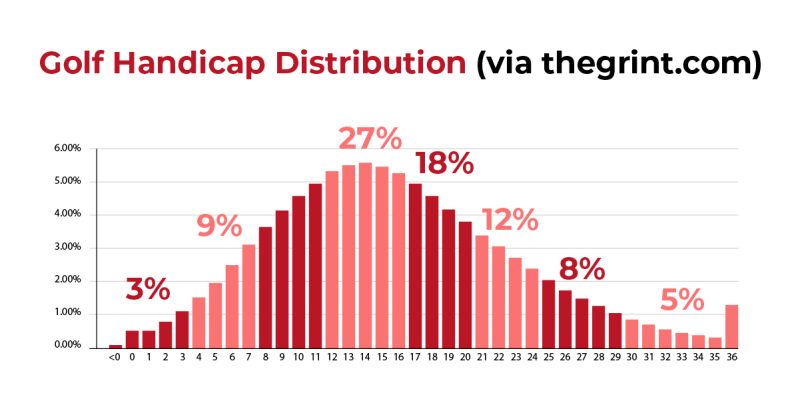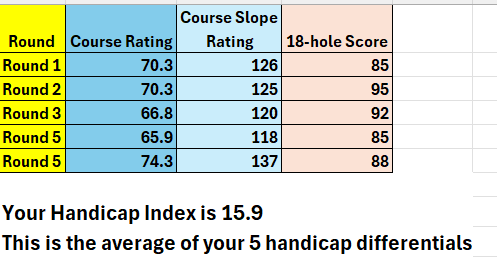Uncategorized
What is a Handicap in Golf? (A beginner’s guide)
Navigating the intricate landscape of golf involves more than just swings and putts. It encompasses a unique numerical system that acts as a compass for fair competition and skill enhancement – the handicap. In this blog, we delve into the depths of what a handicap in golf truly means, how it’s calculated, and why it’s an indispensable facet of the sport.
1. Understanding the Basics of Handicap in Golf
1.1 Definition of handicap in golf
A handicap in golf is a standardized system that levels the playing field among players of varying skill levels. It serves as a measure of a golfer’s ability, allowing individuals of different proficiency levels to compete on an equitable basis. The handicap system essentially accounts for the fact that not all players have the same level of skill and experience. It’s a numerical representation assigned to each player, indicating their expected performance relative to a scratch golfer (a player with a handicap of 0). The higher the handicap, the less experienced or skilled the player is considered to be.

The handicap system ensures that a beginner can play against an advanced player with a fair chance of winning. It also adds an element of strategy and challenge to the game, as players must calculate their strokes based on their respective handicaps. While the system encourages competition, its primary goal is to promote camaraderie and fair play in golf by allowing players of differing abilities to enjoy the game together.
1.2 A numerical representation of a golfer’s skill level
A golfer’s handicap is a numeric value that quantifies their skill level in relation to the theoretical skill level of a scratch golfer. It provides a standardized way to compare players’ abilities across various courses and conditions. A lower handicap reflects a higher level of skill, while a higher handicap suggests a less skilled player. For instance, a player with a handicap of 10 is expected to perform better than a player with a handicap of 20.
The numerical representation is derived from a complex formula that considers a player’s recent scores, the difficulty of the courses played, and other factors. This formula ensures that the handicap accurately reflects a player’s current ability. The handicap system facilitates fair competition by allowing players to adjust their scores based on their respective handicaps, which in turn determines the number of strokes they receive or give during a match.
2. How Handicap in Golf Works
2.1 Calculation process
The calculation process of a golf handicap involves a series of steps aimed at accurately determining a player’s skill level. It begins with a player submitting their recent scores to a golf club or association. These scores are then used to calculate the player’s Handicap Differential, which is the difference between their score and the Course Rating adjusted for Slope Rating. The differentials from a set number of rounds are averaged to create the player’s Handicap Index.
To ensure fairness, the number of scores used, often called the “best 10 of 20,” prevents a single exceptional round from unduly affecting the handicap. The Handicap Index is then further adjusted based on the specific course’s Slope Rating and other local factors to yield the Course Handicap, which is the player’s handicap for that particular course. This calculated number determines the number of strokes the player receives or gives during a round.
2.2 Course Rating and Slope Rating
The Course Rating and Slope Rating are fundamental components of the handicap calculation. The Course Rating represents the expected score of a scratch golfer under normal conditions, while the Slope Rating reflects the relative difficulty of the course for an average golfer compared to a scratch golfer. Courses with higher Slope Ratings are more challenging, and this rating plays a crucial role in adjusting a player’s handicap for a specific course.
The combination of Course Rating and Slope Rating ensures that players’ handicaps accurately reflect their abilities regardless of where they play. A more challenging course will result in a higher Course Handicap for a given player, while an easier course will result in a lower Course Handicap, effectively leveling the playing field.
2.3 Example

Consider a golfer with a Handicap Index of 12.0. If they’re playing a course with a Course Rating of 70 and a Slope Rating of 120, the calculation process comes into play. The player’s Handicap Index is multiplied by the Slope Rating and divided by 113 (the standard Slope Rating) to determine the Slope Factor. In this case, it’s (12.0 * 120) / 113 ≈ 12.7.
The Slope Factor is then added to the Course Rating, resulting in a “Playing Handicap” of approximately 82 (70 + 12.7). This Playing Handicap is used during the game to determine the number of strokes the player receives or gives based on the difficulty of the course. This example illustrates how the handicap system ensures equitable competition on courses of varying levels of difficulty, allowing players to compete fairly regardless of the course’s challenges.
3. Why Handicap in Golf Matters
3.1 Creating fair and competitive matches
The Handicap in golf holds a pivotal role in creating fair and competitive matches among players of diverse skill levels. Without this mechanism, matches could easily become imbalanced and less engaging. Handicaps ensure that players with differing abilities have an equal opportunity to vie for victory. By adjusting each player’s expected performance, the handicap levels the playing field and fosters an environment where everyone can enjoy the thrill of competition. This fairness is integral to the essence of golf, promoting sportsmanship and camaraderie while motivating players to improve.
3.2 Varying abilities to compete on an equal footing
The Handicap in golf acts as an inclusive bridge, allowing golfers of varying abilities to compete on an equal footing. Novices can share the course with seasoned players without feeling overwhelmed, fostering a sense of unity among players of all backgrounds. This inclusivity not only enriches the golfing experience but also encourages skill development. Handicaps empower beginners to challenge themselves against tougher opponents, promoting a continuous journey of improvement for all involved.
3.3 Role in various formats like stroke play and match play
The significance of the Handicap in golf transcends different game formats, including stroke play and match play. In stroke play, it facilitates fair competition by allowing players to be assessed based on their net scores, considering their handicap. In match play, the handicap determines the number of strokes given or received in each hole, introducing a strategic dimension to the game. Handicaps ensure that match outcomes remain uncertain and exciting, showcasing the dynamic nature of golf as players of all skill levels engage in thrilling battles that transcend mere numbers.
4. Obtaining a Handicap in Golf
4.1 Joining a Recognized Golf Club or Association
To initiate the process of obtaining a handicap, beginners should consider joining a recognized golf club or association. These entities are authorized to manage and administer the handicap system. Being a member provides access to official courses, scorecards, and the necessary infrastructure for handicap management.
4.2 Submitting Scorecards and Establishing a Starting Handicap
Upon joining a club or association, beginners need to start playing rounds and submitting their scorecards. Typically, a player is required to submit a certain number of scorecards, often referred to as “posting scores,” to establish a valid handicap. This process involves playing rounds with other golfers and recording your scores accurately.
4.3 Calculating Handicap Index
The golf club or association will use the scores you’ve submitted to calculate your Handicap Index. This index reflects your potential ability and serves as the baseline for your handicap. The formula involves considering your best scores and applying adjustments based on the Course Rating and Slope Rating of the courses you played.
4.4 Playing to Your Handicap
Once you have a Handicap Index, you can use it to calculate your Course Handicap for specific courses. This Course Handicap is what you’ll use during rounds to adjust your score based on the difficulty of the course. It ensures that you’re playing on an equal footing with other golfers, regardless of the course’s challenge.
4.5 Continuous Improvement
As you continue to play and submit scores, your Handicap Index will be regularly updated to reflect your current performance. The system adapts to your progress, motivating you to strive for improvement and providing a tangible measure of your golfing journey.
5. Benefits of Having a Handicap in Golf
5.1 Measurable Progress and Motivation
Having a handicap in golf provides a tangible measure of your skill development over time. It’s a numerical reflection of your performance, allowing you to track improvements, no matter how incremental. Witnessing your handicap decrease signifies that your efforts and practice are translating into better scores. This ongoing progress acts as a powerful motivator, spurring you to consistently refine your game and strive for a lower handicap, enhancing your overall golfing experience.
5.2 Level Playing Field for Various Competitions
A handicap in golf ensures that players of different skill levels can participate in competitions on a level playing field. It permits novices and veterans to compete fairly, as handicaps adjust scores to reflect individual abilities. This inclusivity not only fosters healthy competition but also encourages beginners to actively engage in matches, improving their skills and bolstering their confidence along the way. With a handicap, the focus shifts from sheer scores to fair competition, making the game more enjoyable for all participants.
5.3 Set Goals and Measure Performance
A handicap enables you to set personalized goals for your game. Whether it’s aiming to achieve a specific handicap index or consistently improving your Course Handicap, having a clear benchmark motivates you to push your boundaries. Regularly updated handicaps provide a concrete measurement of your achievements, offering insight into your strengths and areas that need refinement. This data-driven approach to golf allows you to make informed decisions about your practice regimen, helping you tailor your efforts to see maximum progress.
5.4 Enhanced Social and Networking Opportunities
A handicap in golf opens doors to social interactions and networking opportunities within the golfing community. By participating in tournaments, leagues, or club events, you connect with fellow players who share your passion. Your handicap acts as a conversation starter and a common ground, fostering friendships and connections that extend beyond the course. Engaging with others who have diverse handicaps brings fresh perspectives to your game and exposes you to different strategies, contributing to your growth as a golfer and enriching your overall experience.
6. Conclusion
In conclusion, understanding the intricacies and benefits of the handicap system in golf is a vital step in elevating your experience on the course. As you work towards honing your game, remember that the handicap system not only adds depth to your matches but also connects you with a community that shares your passion for the sport.
For more insightful articles and a deeper dive into the world of golf, stay updated with Golfbiz’s blogs, where you’ll find a wealth of knowledge to enhance your golfing prowess.
